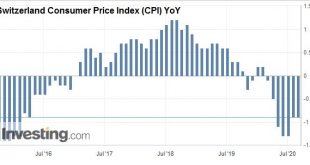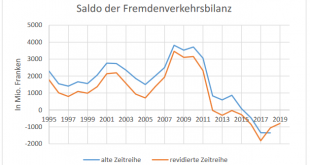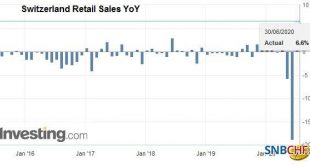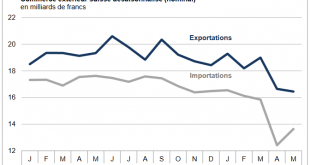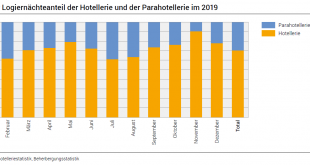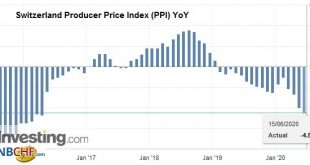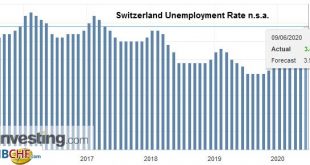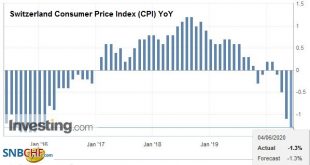The sell-off in stocks last week showed a certain nervousness about the sharp run-up in tech stocks and the role of big option bets. Indeed, prices in some instances had risen too fast. But this was a technical correction. With the US tech titans generating free cash flow, we do not believe we are facing a repeat of the bursting of the dot-com bubble in 2000. And yet, it could be that Tesla’s ambition to raise USD5bn through occasional share sales will be seen as...
Read More »Swiss Consumer Price Index in August 2020: -0.9 percent YoY, 0.0 percent MoM
03.09.2020 – The consumer price index (CPI) remained stable in August 2020 compared with the previous month, reaching 101.2 points (December 2015 = 100). Inflation was –0.9% compared with the same month of the previous year. These are the results of the Federal Statistical Office (FSO). The stability of the index compared with the previous month is the result of opposing trends that counterbalanced each other overall. Prices for clothing and footwear increased, as...
Read More »No lack of foreign tourism demand in 2019
07.07.2020 – Foreign demand was strong in 2019. The income side of the tourism balance of payments grew, reaching a record level of CHF 17.8 billion. At the same time, people living in Switzerland did not increase their expenditure when travelling abroad, despite price conditions that were more favourable. The tourism balance of payments was negative at CHF -798 million, according to initial estimates from the Federal Statistical Office (FSO). Saldo der...
Read More »Swiss Retail Sales, May 2020: 5.6 percent Nominal and 6.6 percent Real
30.06.2020 – Turnover adjusted for sales days and holidays rose in the retail sector by 5.6% in nominal terms in May 2020 compared with the previous year. Seasonally adjusted, nominal turnover rose by 30.2% compared with the previous month. These are provisional findings from the Federal Statistical Office (FSO). Real turnover adjusted for sales days and holidays rose in the retail sector by 6.6% in May 2020 compared with the previous year. Real growth takes...
Read More »Weekly View – Reality check
[embedded content] The short-term pull-back in stock prices last week on the back of persistent virus concerns in the US and elsewhere shows the market remains jittery despite the massive run-up in prices since late March. May data from China showed a relatively fast rebound on the supply side of the economy, but a much slower take-off in consumption, suggesting a ‘reverse square root’ kind of recovery for economies rather than the ‘v’-shaped one markets have been...
Read More »Swiss Trade Balance May 2020: signs of recovery in foreign trade
We do not like Purchasing Power or Real Effective Exchange Rate (REER) as measurement for currencies. For us, the trade balance decides if a currency is overvalued. Only the trade balance can express productivity gains, while the REER assumes constant productivity in comparison to trade partners. Who has read Michael Pettis, knows that a rising trade surplus may also be caused by a higher savings rate while the trade partners decided to spend more. This is partially...
Read More »Supplementary accommodation: 0.7 percent increase in overnight stays in 2019, but decrease in demand for holiday homes
15.06.2020 – In 2019, supplementary accommodation posted a total of 16.7 million overnight stays, i.e. an increase of 0.7% compared with 2018. With 11.4 million units, Swiss visitors represented more than two-thirds of demand (68.6%), i.e. a rise of 2.4%. Foreign visitors registered a 2.8% decrease with 5.2 million units. With 4.4 million overnight stays (-3.8%), European visitors accounted for the majority of stays by foreign guests. These are the final results from...
Read More »Swiss Producer and Import Price Index in May 2020: -4.5 percent YoY, -0.5 percent MoM
The Producer Price Index (PPI) or officially named “Producer and Import Price Index” describes the changes in prices for producers and importers. For us it is interesting because it is used in the formula for the Real Effective Exchange Rate. When producers and importers profit on lower price changes when compared to other countries, then the Swiss Franc reduces its overvaluation. The Swiss PPI values of -6% in 2015 (see below), compared to -3% in Europe or -1% in...
Read More »Switzerland Unemployment in May 2020: rose to 3.4percent, seasonally adjusted rose to 3.4percent
Unemployment Rate (not seasonally adjusted) Bern, June 9, 2020 – Registered unemployment in May 2020 – According to surveys by the State Secretariat for Economic Affairs (SECO), 155,998 unemployed people were registered with the regional employment centers at the end of May 2020, 2,585 more than in the previous month. The unemployment rate rose from 3.3% in April 2020 to 3.4% in the reporting month. Unemployment rose by 54,628 people (+ 53.9%) compared to the same...
Read More »Swiss Consumer Price Index in May 2020: -1.3 percent YoY, 0.0 percent MoM
04.06.2020 – The consumer price index (CPI) remained stable in May 2020 compared with the previous month, remaining at 101.3 points (December 2015 = 100). Inflation was –1.3% compared with the same month of the previous year. These are the results of the Federal Statistical Office (FSO).The stability of the index compared with the previous month is the result of opposing trends that counterbalanced each other overall. Prices for housing rental, international package...
Read More » Swiss Economicblogs.org
Swiss Economicblogs.org


